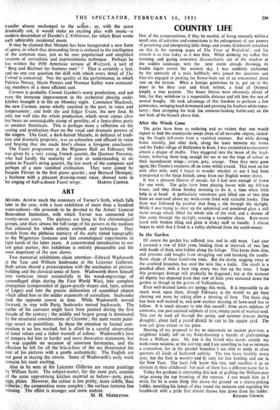In the Garden Of course the garden has suffered, too,
and in odd ways. Last year 1 corseted a row of Irish yews, binding them at intervals of two feet with bands of thick wire hidden along the foliage. This keeps them slim, and prevents odd boughs from straggling out and breaking the candle- flame shape of these handsome trees. But the storm, nagging away at the confined branches, has used the wire like a knife. The result is a poodled effect, with a bare ring every two feet up the trees. I hope this grotesque damage will gradually be disguised ; but at the moment all dignity has departed from that row of Irish yews stationed down the garden as though in the groves of Vallombrosa.
Even well-drained lawns are spongy this week. It is impossible to do much work upon them, though February is the month to get busy clearing out moss by raking after a dressing of lime. The basic slag has been well washed in, and now another dressing of lawn-sand has to follow. It is much cheaper to mix this oneself: three parts sulphate of ammonia, one part calcined sulphate of iron, twenty parts of washed sand. This can be used all through the spring and summer (except during drought); about half a pound should be cast to the square yard. The iron salt gives colour to the grass.
Hearing of my proposal to try to rejuvenate an ancient pear-tree, a neighbour kindly left on my front-doorstep a bundle of graft-cuttings from a William pear. My tree is the friend who stands outside my work-room window, at the oast-top, and I am unwilling to lop so intimate a connection, for in his gnarled branches I am able to study at close quarters all kinds of feathered activity. The tree bears lavishly every year, but the fruit is wooden and fit only for late bottling and use in the New Year. The local folk know this tree, and recollect it as an element in their childhood: but each of them has a different name for it.
Today the gardener is attempting this task of grafting the William-pear twigs among the top branches of the veteran. I can watch him as I write, for he is some thirty feet above the ground on a cherry-picking ladder, moulding his lumps of clay round the incisions and regarding his handiwork with a pride that almost throws him down from the ladder.
RICHARD CHURCH.


































 Previous page
Previous page